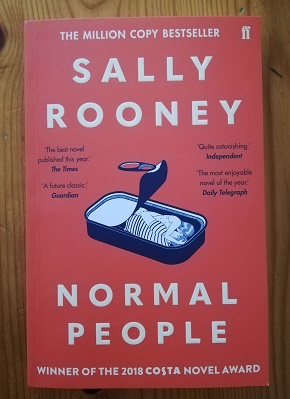Normal People broke the RTE player records – proving more popular than the much-lauded gritty crime drama ‘Love/Hate’. What is it about two very average, overly intelligent people from Sligo, and a silver necklace, that captured the public imagination? And led Kourtney Kardashian to tweet an appeal for a second series? Sally Rooney’s award winning novel certainly encapsulated the zeitgeist as the world entered into lockdown.
Rooney’s writing is like the marmite of the literary world, lauded by some, and dismissed by others. Her pared back minimal style sets her apart from some recent Irish literary fiction successes. There is none of the narrative gymnastics of Eimear McBride’s A Girl is A Half-formed Thing, or the beautiful descriptive prose of David Park’s Travelling in A Strange Land. Instead Rooney opts for the bare bones of the story, allowing just the characters to be. In fact, the location manager of the adaptation, told The Irish Times, that her lightly sketched locations allowed for real freedom in filming.[1] There is nothing extra to get lost in or be distracted by in her written work – which has a minimalistic joy itself. The lack of punctuation in her dialogue, or use of email conversations is nothing new in contemporary fiction, and her love stories have been compared to Austen[2]. So what is it about this writer of ‘post’-postcrash fiction that has made her so popular?
Unlike many of her contemporaries the crash and the Celtic Tiger very much feature in the background of her stories – this is no Solar Bones trying to grapple with what Gerry Smyth called the ‘extreme assault’ on Irish identity[3]. And while the book Normal People contains one solitary reference to a ghost estate, it is telling how far we’ve come since 2011, when that estate is no longer included in the TV adaptation, and replaced by an unfinished one off rural house. Other slight signifiers of Ireland’s property boom and bust, like her property developer boss, or Jamie’s ‘new money’ wealth, have been removed from the adaption. This adds to the scant nature of her narrative, making the material safer, more universal. This is firmly about Connell and Marianne, and while they might from time to time discuss ideologies, we can’t get distracted by political, cultural or social events or the reality of present day neo-liberal Ireland.
This is what makes it such good Covid television. Unlike the chaos of the outside world presently, Normal People was like a form of slow television. It is the series equivalent of waiting for your sourdough starter to mature. There was nothing here to remind you of the pandemic, and the style allowed you to completely invest in the slow, silent, soft colour palette of two young, beautiful people trying to make it in a world without a coronavirus. This intimate story offered universal themes, of love and loss, and Irish specific cultural references like the debs, and a shared bag of opened crisps on the pub table. It even had the old ‘normal’ leaving cert. As Maria Tivnan suggests there is an ‘intangible draw’ for us in the familiarity and current strangeness of ordinary life.[4] Something comforting in a simple introspective love story. There’s nothing unexpected here, no John McCain jumping out of the shadows, no ‘Winter is coming’, no missing Baskin husband, no pandemic. It’s like a warm blanket, with more sex, and GAA shorts.
This is a very simple, and common, story of growing up in rural Ireland, and moving to the big city for university. It’s my own experience, growing up in very, very, rural Ireland, and suddenly finding myself in a classroom with more students than the population of my local village. It is the story of leaving your small town, and having the opportunity to reinvent yourself like Marianne. Or become lost, like Connell. Rooney refuses to be trapped by the clichés that are too often used in representations of rural Ireland. Still including those rites of passage, like the debs, the CAO, the secondary school cliques and losing your virginity, she maintains a respect for the reality of rural Ireland without bending to the ideal of the purity of West. I wonder had she set her story in Dublin, would Joe Duffy’s Liveline have been as animated over the consensual sex of two Dublin teenagers?

Published: 11 Jun 2020 Categories: Covid-19 and the Humanities, Critical Theory, English Literature, Irish Literature

